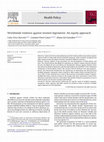Papers by Gaby Ortiz Barreda

Health Policy, 2011
Objectives: To describe the recommendations and interventions addressing violence against women (... more Objectives: To describe the recommendations and interventions addressing violence against women (VAW) in vulnerable women (disabled, pregnant, ethnic minority, immigrant and older women) in key documents and laws enacted in different countries. Methods: Content analysis of key documents for the development of VAW policies and laws: The United Nations Handbook for Legislation on Violence Against Women Advance Version, the Model of Laws and Policies on Intrafamiliar Violence Against Women of the Pan-American Health Organization and Recommendation No. R(2002)5 of the Committee of Ministers of the European Council. The content of the 62 VAW laws was also analyzed. Results: Key documents demonstrate the importance of eliminating any obstacle facing disabled, pregnant, immigrant, ethnic minority or older women when accessing VAW services. Only 12 laws mention one or more of these groups of vulnerable women. Pregnant, disabled and ethnic minority women are the groups most often mentioned. In these laws, references to punitive measures, action plans and specific strategies to guarantee access to VAW resources are the most common interventions. Conclusion: Decisive interventions addressing the specific needs of disabled, pregnant, immigrant, ethnic minority and older women are needed in order to achieve a broader equity approach in VAW legislation.










Uploads
Papers by Gaby Ortiz Barreda